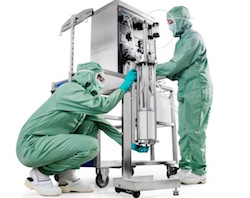This week, the Process Development Forum interviews Rita Peters, editorial director of BioPharm International, about Interphex 2018.

At the 2018 Interphex trade show in New York City in April, the evolution of the bio/pharmaceutical industry was evident at exhibition stands and in presentations during technical sessions. Rita Peters, editorial director of BioPharm International, shares observations of the magazine’s editorial team as they reported on industry developments at the April event.
Q: What insight did FDA share about quality requirements and the agency’s efforts to enhance drug product quality and reliability of supply?
A: Lawrence X. Yu, deputy director of the Office of Pharmaceutical Quality in FDA’s Center for Drug Evaluation and Research, talked about the future of pharmaceutical quality—and the challenges of achieving quality goals, emphasizing the need for a shift to performance-based regulation. Currently, consumers are paying for therapies, but not for quality, he said. When they purchase other consumer products, quality is expected, or the buyer will turn to other suppliers.
Drug manufacturers need to improve the performance of individual and organizational behavior as a way to protect human health, and set a goal of achieving Six Sigma, he said. Technologies such as machine learning, big data, process analytical technology, and automation can assist in the move to performance-based regulation.
FDA has been actively encouraging drug manufacturers to embrace new technologies to accelerate the development and manufacture of drugs. For example, FDA has been an active proponent of continuous manufacturing for small-molecule drugs. Now that several drugs manufactured via continuous processing have been approved, the interest in this processing method has increased significantly.
Q: Can biologic-based drug developers learn any lessons from the continuous manufacturing experiences of the small-molecule market segment?
A: A BioPharm International panel discussion on the outlook for continuous manufacturing for biologic-based drugs at Interphex was attended by a standing-room only audience, indicating strong interest in the topic. The consensus from the expert panel members was that the differences between the small-molecule versus large-molecule processes were too strong to draw one-to-one comparisons. However, the need to take a holistic look at an entire manufacturing process to assess paths to process improvement is applicable to both market segments.
Panelists suggested that a complete end-to-end continuous manufacturing process for bioprocessing may be an elusive goal; however, continuous operations may help in some segments of a full process.

Continuous processes currently are implemented in commercial manufacturing for upstream operations but not for downstream processes, the panelist noted. There is some potential for continuous manufacturing to help in downstream operations, with hybrid configurations a potential solution. The panelists, however, expect the changes to be evolutionary, not revolutionary.
Panelist Parrish M. Galliher, CTO, Upstream, Cytiva and founder of Xcellerex Inc., recommended that biopharma companies conduct a bottleneck analysis to see if continuous manufacturing may help in process segments.
A significant roadblock to the implementation of continuous bioprocessing is the need for improved process analytics to measure critical quality attributes (e.g., protein function) in real time. Another challenge is maintaining sanitary conditions in a continuous process; the control of bioburden, while basic, is fundamental to success, said Galliher.
Implementing automation technology can improve efficiency, help address the complexity of continuous processing, and assist in the challenge of training operators to run new systems. And, as more automation and control systems are incorporated in manufacturing processes, and more systems become Internet-enabled, the need for process security becomes paramount.
Q: How are equipment and materials suppliers meeting the demand for emerging drug therapies?
A: FDA’s approval in 2017 of cell- and gene-therapies created a great deal of excitement in the industry. Some of that excitement continued among industry suppliers this year. Cytiva introduced prefabricated, modular KUBio manufacturing units for the production of viral vector-based therapeutics including viral-vector based vaccines, oncolytic viruses, and gene and cell therapies.
However, most product introductions focused on enhancements to existing product lines or technologies to improve current biopharmaceutical manufacturing processes. A recurring theme was the need for new technologies to accelerate bioprocessing operations and to smooth scale-up from development to GMP processing.
Exhibitors announced new chromatography systems for pilot- and small-scale production, new resins, mixing systems, kits for glycan analysis and mycoplasma detection, filters, and sensors.
As biologic-based therapies continue to evolve, drug companies are demanding more scalable systems, faster changeover, and more flexibility.
Read more Q&As with Industry Leaders Here